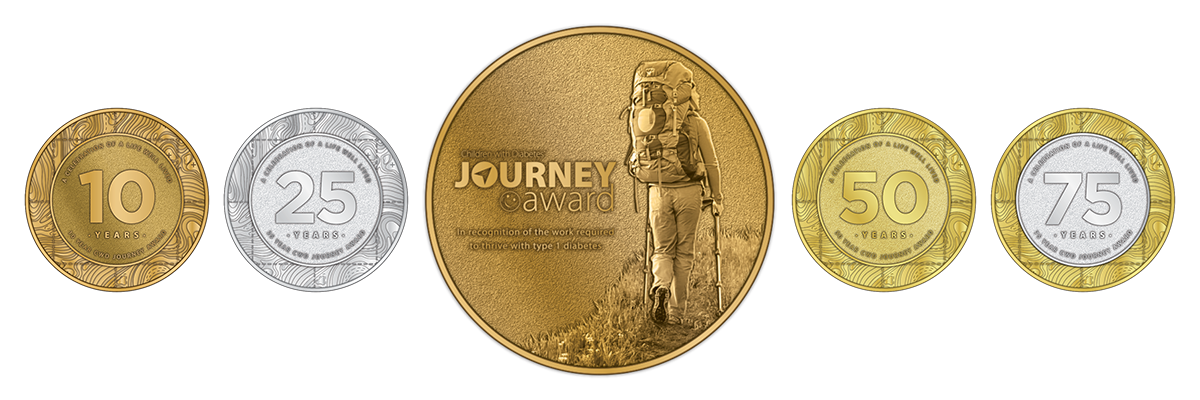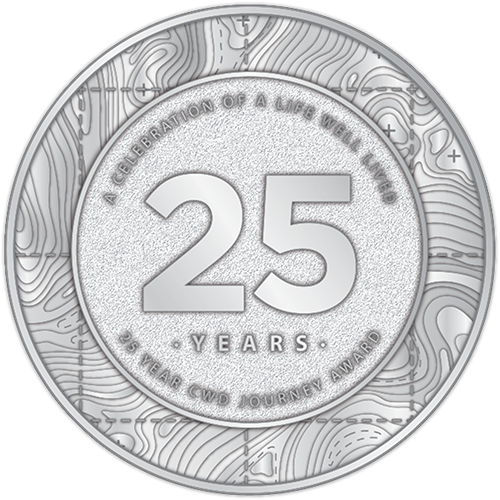
Leah Chouinard
Hi! I’m Leah, I’m currently 26 years old, and I am celebrating 25 YEARS with type 1 diabetes! Considering that I’ve had diabetes most of my life, my diabetes story is far from brief, capturing the toddler, elementary, teenage, college, and young adult seasons of my life. My story is full of both vivid and vague memories regarding my life as a type 1 diabetic, and the memories range from joyful and empowering to frightening and isolating. Over the years, I have daily faced a fear of needles, sacrificed countless hours of sleep to care for my diabetes, and educated many people along the way. I gained a deep interest in the human body and holistic well-being and have a deep sense of compassion for everyone navigating health challenges. Please enjoy reading my diabetes story, which I’ve had the pleasure of remembering and writing to commemorate this significant anniversary.
Diagnosis:
Having been diagnosed two months before my second birthday, I don’t have a single memory without diabetes, but my parents recall my diagnosis vividly. After a period of flu-like symptoms and failed attempts at treating my symptoms with antibiotics, my pediatrician decided to try one last thing – “let’s check her blood sugar.” When the doctor returned to the room, he looked at my parents, and in a serious-but-calm fashion, he said, “drive straight to the emergency room; you don’t need to take an ambulance; they’ll be waiting for you.”A five-day hospital stay ensued, which began in the PICU and ended in a traditional hospital room where my parents were educated on how to check my blood sugar, count carbohydrates, fill out a BG and insulin logbook, check ketones, treat low blood sugars, and give insulin injections (first to oranges, and then to humans).
Childhood:
As a kid, I was aware that I was unique compared to other kids. I knew that I took insulin shots and checked my blood sugar while others didn’t, but I didn’t know exactly why. I remember how my preschool teachers and other adults would get concerned if I stared off into space for too long (fearing I was low), and I quickly learned not to do that, because I didn’t like the attention in front of a group of people, and I didn’t want to worry the adults in the room! My first diabetes milestone occurred when I was about four years old and started independently checking my blood sugar. At my next endocrinology appointment, my mom said, “…and Leah, you should tell Doctor R what you’ve been doing by yourself,” and I shyly shared my great accomplishment, not realizing how incredible it truly was.
In my younger years, I had occasional episodes of feeling confused, and I would trip clumsily over my own feet while walking around my classroom. Again, wanting to spare myself embarrassment and not “knowing” what was happening, I would casually laugh off my uncoordinated actions, until, at the end of first grade, “that feeling” of doom and dissociation came over me and I finally put two and two together: I dazedly walked to my teacher’s desk, looked straight into her eyes, and said, “Mrs. T…I feel low.” She immediately got up, took my hand, and walked me to the nurse’s office, where the school health nurse was the most ELATED I’d ever seen her. “I’m so proud of you!!!” she exclaimed as I sat on a cot and drank juice boxes, as per my low routine.
Throughout my childhood, I knew very well that I had diabetes, but diabetes never once took center stage in my life. Of course I had the “scary overnight lows” a handful of times while still on injections, and I threw the occasional fit because I didn’t feel like having an insulin shot at times, but overall, I participated in life like a typical child: I played piano, sang in church choir, loved playing with my siblings and cousins, and was the “tagger” in tag with my friends at recess every day. However, at the same time, my parents were teaching me how to count carbohydrates, which I learned quickly, and I would sometimes joke with friends, saying I was playing a videogame on my pump (a feature we haven’t seen on our insulin pumps…YET!)
At age 7, I advocated for my transition from multiple daily injections to an insulin pump, which was life-changing. After overcoming my fear of site changes due to my fears of needles, pain, and anything new regarding diabetes management, I started going to sleepovers at friend’s houses, said goodbye to severe lows, and attended both day- and overnight camps in the summer, including Camp Needlepoint in Hudson, WI.
Teenage Years:
During my adolescent years, I assumed complete control over my diabetes – aside from changing the infusion sets for my pump – thanks, Dad!! This allowed me to live life with fairly little diabetes-related stress, but I also became very nonchalant with regard to my diabetes management. Over the years, I forgot how many carbohydrates were in basic food items and resorted to guessing how much to bolus for meals and snacks. I would rarely bolus before eating, but when I did, I appreciated the stability of my numbers. I rarely read a carbohydrate label, and I suspended my pump frequently to avoid lows because I didn’t want to miss any lessons in class and need to catch up later. I never wanted to leave during an exam or sit out of a band or choir rehearsal due to low blood sugars, so I carelessly aimed high. This pattern led to my highest A1c, 9.6%. I opted to meet with a psychologist about my “fear of lows,” which really translated into my “fear of missing out on life,” and from being more intentional about my bolusing, I achieved A1c’s in the 8.0 range in subsequent years. Having always had a fear of needles and pain, it wasn’t until I was 15 when I did my first site change, and age 18 when I started doing 100% of my site changes (sparing those hard-to-reach places!)
Despite my diabetes, I marched in my high school’s drumline for four years, volunteered, participated in musical theater, became a Peer Minister and led younger students at my church, earned several accolades as a percussionist, and graduated high school with a high GPA.
College CGM
I have fond memories of my college years, although I continued with my nonchalant diabetes management. Over time, I learned to check my BG more frequently, but ultimately, my avoidance of lows made my need for a continuous glucose monitor apparent. I started using a CGM during my junior year of college. It changed everything in my life for the better, aside from my frustration with overnight alerts that would awaken me a little too often and the need to navigate and troubleshoot technology challenges.
College presented me with a great opportunity to lean into my identity as a diabetic, which I brushed off to the side for the majority of my life prior to going to college. I had always wanted to embrace my diabetes more throughout my lifetime, and I share with utmost gratitude that all of my college friends were extremely caring when it came to my diabetes. They were curious to learn about my lifestyle and needs, looked out for me at events where alcohol was present, and never once judged me for how I lived my life.
I graduated magna cum laude with my degree in psychology with many nutrition, neuroscience, and health-related courses along the way.
Currently:
I now work part-time in youth ministry at a large church while finishing my Master’s Degree in integrative health and well-being coaching at the University of Minnesota. I am a percussionist in a professional wind ensemble, but I also spend a great deal of my time taking care of my health. Unfortunately, autoimmunity got the best of me, where in addition to type 1 diabetes, I was struck with Graves’ disease (hyperthyroidism) when I was 13 years old, and when I was 20, I was diagnosed with rheumatoid arthritis, which has been a deeply challenging journey, but that journey has allowed me to come home to my truest self and become keenly aware of my physical and emotional needs. For better and for worse, my health focus shifted to managing the causes of autoimmune activity in my body rather than giving my best to my diabetes management. I theorize (and evidence supports) that my lack of stable blood sugars has worsened the progression of my RA. At the same time, I have been able to continue living my life with RA and have come ENTIRELY off of medications for thyroid disease due to the integrative and holistic approaches I have implemented.
Only a year ago did I learn that I have been living with undiagnosed ADD/ADHD, which has made managing diabetes an immense, nearly impossible struggle. Finally, I have been able to release the guilt and shame and feelings of low self-esteem regarding my haphazard diabetes care. Having an ADHD diagnosis has explained why I could never adhere to carb counting (my brain would get “bored” when measuring serving sizes and googling carb counts), why I would procrastinate site changes and ordering supplies (these step-by-step processes took focused time and attention, and my mind would gravitate toward more stimulating activities), and why I would fail to complete a bolus on my pump, because I would miss hitting the “enter” button one final time.
I’m excited to have just upgraded my Medtronic pump to the latest version, 780G, and already have noticed greatly-improved blood sugars. My next goals are to expand my knowledge of carb values, ease my remaining fear of lows by over-preparing for low blood sugars to occur anytime, anywhere, and to carefully dose my insulin several minutes before sitting down to eat. I highly doubt I’m alone in having such goals! 😉
I look forward to having the best-managed, most-controlled, least life-interfering diabetes in the next 25 years of my life, and I cannot wait to write the next chapter of my story when receiving my 50-year T1D gold medal.
All the best to the diabetic community and to all of the caring friends and family members of people with diabetes,
Leah Chouinard

since 1998

Do you have a story to share about your experiences with diabetes? We want to hear from you! Tell us your story using the form below and we'll consider it for inclusion in the CWD Stories section of our website.